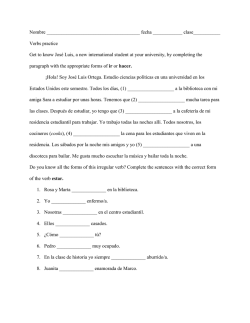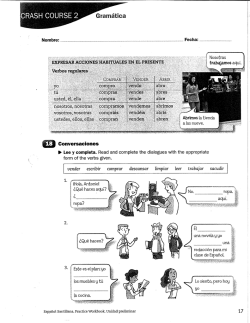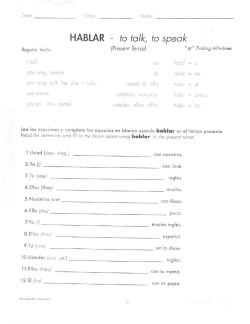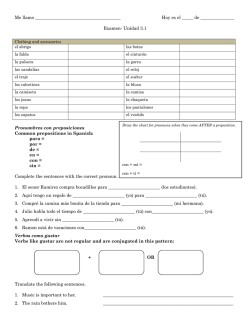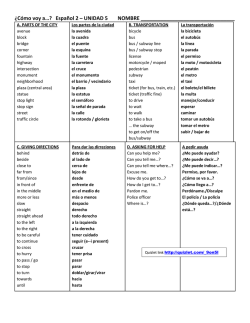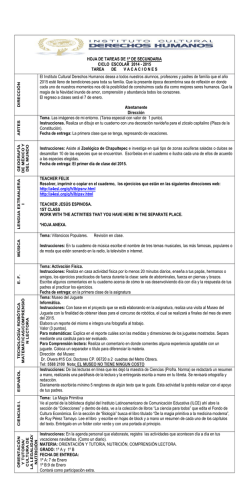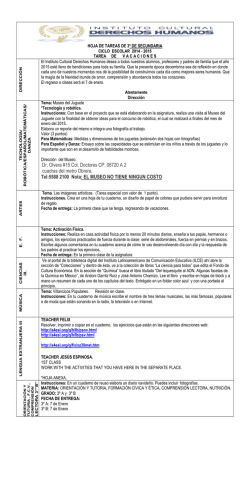
CAPÍTULO 3B A. Write the vocabulary word that matches each
Nombre ________________________________________________ CAPÍTULO 3B A. Write the vocabulary word that matches each description below. 1. Un hombre que camina al lado de la calle ______________________________________ 2. Luces para organizar el tráfico ______________________________________ 3. Una mujer que maneja un vehículo ______________________________________ 4. Muchos coches en la calle ______________________________________ 5. Un vehículo grande para transportar muchas cosas _______________________________ B. Hernan is showing photos of his trip to Argentina. Complete his comments by writing the missing words. Use the clues in the pictures. 1. Mis tíos viven en la parte vieja de la cuidad. La calle es muy ____________________. ¡Dos coches no pueden pasar al mismo (same) tiempo! 2. Esta plaza tiene dos ____________________ muy bonitas y una estatua. 3. Aquí un policía me pone una ____________________ por no parar en la ____________ _____ _______________ de estas dos calles. 4. Para llegar al estadio debes seguir ____________________ por esta calle, sin (without) doblar. El estadio está a sólo una ____________________de aquí. 5. El fin de semana fuimos al centro de la ciudad en el ____________________. Después fuimos a pie ____________________ llegar al museo. 6. C. Tuvimos que cruzar por este _____________ para llegar al otro lado de la _________________. While Señora Robledo was in Mexico City on business, she wrote to her husband. The following is a portion of her letter. Complete the sentences by writing the appropriate words in the spaces provided. One or more letters of each word have been provided. Es muy difícil __ __ __ __ j __ __ en la Ciudad de México. ¡Hay tanto __ __ __ f __ c __ y es tan __ __ m p __ __ __ __ __ __ saber cómo se va de un lugar a otro! Es mejor __ __ j __ __ el coche y caminar por las calles y las __ __ __ z __ __ mirando las __ __ __ n t __ __ impresionantes y las __ __ t __ t __ __ __ de personas importantes de México. También es divertido pasar por las __ v __ __ __ __ __ __ grandes y a __ __ h __ __ donde hay muchas tiendas interesantes. Pero cada __ __ __ __ o __ tiene que prestar atención al __ __ __ z __ __ la calle, porque algunos __ __ __ __ __ c __ __ __ __ __ no respetan los __ __ __ __ f __ __ __ __ amarillos o rojos. Como en todas las ciudades grandes las personas tienen __ r __ __ __ y van muy rápidamente por las calles. Pero me gusta mucho la Ciudad de México. ¡Es una ciudad tremenda! D. Bernardo’s older brother Kiko is helping him prepare for his driving test next week. Fill in the blanks with the appropriate word or words. KIKO: ¿Estás ____________________ de que aprendiste de memoria todas las reglas de tráfico? KIKO: Cuando manejas por una calle donde hay una escuela es importante manejar muy ____________________. No debes manejar rápidamente en una zona escolar. KIKO: Un ____________________ puede ponerte una ____________________ si manejas muy rápido o muy mal. KIKO: La policía te puede ____________________ el permiso de manejar si no respetas las reglas de tráfico. KIKO: Puedes ____________________ a la derecha después de parar en un ____________________ que está en rojo. BERNARDO: ¡____________________! ¡Me estás _______________ ________________! ____ sé todo lo que necesito saber para el examen. KIKO: De ____________________. E. Police sergeant García is tracking a suspicious-looking vehicle. Complete his remarks, made over the radio to the police station. In the space provided write the appropriate word or words that describe what is happening in the pictures. 1. ¡Atención! Seguimos un coche ____________________ la calle del Parque hasta la avenida de la Constitución. 2. El coche ____________________ a la derecha en la ____________________ de la avenida de la Constitución y la calle Managua. 3. Acaba de pasar por el _____________ _____ ________________ de la avenida Bolivia con la avenida Perú. 4. El coche sigue ____________________ por el Paseo de la Independencia. 5. Ahora dobla a la derecha y toma la ____________________ que va al aeropuerto. 6. En estos momentos el coche para en la señal ____ ____________________. Está ____________________ a dos o tres ____________________ de nosotros. 7. Ahora está cruzando el ____________________ sobre el río. 8. Un hombre sale del coche con algo en las manos y corre hacia un ____________________ grande. Atención todos los policías. Deben tener __________________ porque el hombre puede ser __________________ y debemos esperar. F. Leer: Susi sees an article listing tips for driving safely, entitled Los principales consejos (advice) para manejar. Circle, mark, or highlight the 5 suggestions from the list that would NOT appear in the article AND translate them to English. Los principales consejos para manejar 1) Para completamente en la señal de parar. 2) Maneja lentamente cuando estás cerca de una escuela y hay niños en el patio de recreo. 3) Si llueve (If it rains), ve más rápido. 4) En la carretera, es importante manejar más rápido que los otros conductores. 5) Mira a la izquierda y la derecha cuando estás en un cruce de calles. 6) Ten mucha prisa al pasar por un semáforo amarillo. 7) Si estás aburrido en el coche, habla por teléfono. 8) Para completamente y espera cuando pasan los vehículos de emergencia, como las ambulancias. 9) Deja pasar los autobuses de las escuelas. 10) Cuando quieres ir al banco sólo (only) por un momento, puedes dejar el coche en medio de la avenida. COMMANDS: Familiar/Informal Tú commands: Use the _____ or _____ form of the present tense OR the _______ form minus the ____. Irregular tú commands: Ven (____________) Ten (____________) Di (____________) Sal (____________) Haz (____________) Ve (____________) Pon (____________) Sé (____________) G. Your mom gives you the following commands. Escribe los mandatos en español. 1. Arrive on time! __________________________________________________________________________________ 2. Participate in the chess club! ______________________________________________________________________ 3. Memorize the words! ____________________________________________________________________________ 4. Be careful! _____________________________________________________________________________________ 5. Pay attention! __________________________________________________________________________________ 6. Put on the elegant dress! _________________________________________________________________________ 7. Cash a check! __________________________________________________________________________________ 8. Return the book to the library! ____________________________________________________________________ 9. Buy the leather jacket! ___________________________________________________________________________ 10. Tell the truth (la verdad)! _________________________________________________________________________ 11. Do the chores! _________________________________________________________________________________ 12. Be hardworking! ________________________________________________________________________________ 13. Get in the car! _________________________________________________________________________________ 14. Get off at the Zócalo subway stop/station! ___________________________________________________________ 15. Drive slowly the highway is dangerous! ______________________________________________________________ H. Jennifer is babysitting for her Venezuelan cousins. (1) Write the tú command next to each verb. (2) Circle or highlight the command that complete the sentence. Modelo I. J. Joselito, (venir / ser) ven sé aquí, por favor. 1. Marisa, (poner / tener) _________ _________ cuidado con el gato. No es un juguete. 2. Luis, (hacer / decir) _________ _________ la verdad. ¿Ya te lavaste las manos? 3. Joselito, (tener / salir) _________ _________ del baño inmediatamente. Marisa necesita usarlo. 4. Marisa, (hacer / ir) _________ _________ tu cama ahora mismo. 5. Luis, (hacer / ser) _________ _________ bueno con tus hermanos, por favor. Eres el mayor. 6. Joselito, (ir / poner) _________ _________ a jugar al jardín. ¡Me estás poniendo nerviosa! 7. Luis, (poner / ser) _________ _________ tus cosas en tu cuarto. No quiero ver la sala tan desordenada. (1) Complete the sentences with the affirmative tú commands of the verbs in parentheses. (2) Translate to English. 1. (ser) _________ bueno, Joselito. ______________________________________________________________________ 2. (poner) _________ los libros en el carro. ________________________________________________________________ 3. (venir) _________ conmigo a la playa. ________________________________________________________________ 4. (ir) _________ a pie. Con el tráfico que hay, es más rápido. _________________________________________________ 5. (decir) _________ la verdad. _________________________________________________________________________ 6. (hacer) _________ la tarea antes de llamar a tu novia. _____________________________________________________ 7. (salir) _________ de aquí inmediatamente. ______________________________________________________________ 8. (tener) _________ cuidado. Esta carretera es muy peligrosa. ________________________________________________ Sr. Senande is cleaning the house with the help of his children but they are not cooperating. Complete the orders that he gives to his children using the tú command of one of the verbs: poner, ir, tener, hacer, ser, venir, salir, decir Modelo Ana, ya sal de tu cuarto y ven a ayudar. 1. Ana, por favor ______________ tus patines en el armario. 2. Jorge, ______________ al armario a buscar la aspiradora. 3. Pedrito, ______________ cuidado con esos platos. 4. Jorge, ______________ bueno y haz una ensalada, que ya casi es hora de comer. 5. Ana, ______________ la verdad, ¿todavía estás en tu cuarto? ¡Qué perezosa eres! Positive and Negative Formal Ud, Uds., Nosotros commands: Irregular: Dé (____________) K. Tú (negative) Usted Ustedes Nosotros -AR verbs -es -e -en -emos -ER and -IR verbs -as -a -an -amos Vosotros (negative) -éis -áis Tú positive commands form by using the he/she form of the verb Vosotros positive commands form by changing the ‘r’ to a ‘d’ Beber = bebed Vaya (____________) Sea (____________) Esté (____________) Sepa (____________) Complete the following information Command poner Positive Tú pon Negative Tú no pongas Usted ponga ENGLISH Put! L. 1. Start with YO form. 2. Drop ‘o’ and add opposite endings: ir tener hacer ser venir salir decir no no no no no no no Escribe los mandatos FORMALES (Ud.) en español. 1. Arrive on time! __________________________________________________________________________________ 2. Participate in the chess club! ______________________________________________________________________ 3. Memorize the words! ____________________________________________________________________________ 4. Be careful! _____________________________________________________________________________________ 5. Pay attention! __________________________________________________________________________________ 6. Put on the elegant dress! _________________________________________________________________________ 7. Cash a check! __________________________________________________________________________________ 8. Return the book to the library! ____________________________________________________________________ 9. Buy the leather jacket! ___________________________________________________________________________ 10. Tell the truth (la verdad)! _________________________________________________________________________ 11. Do the chores! _________________________________________________________________________________ 12. Be hardworking! ________________________________________________________________________________ 13. Get in the car! _________________________________________________________________________________ 14. Get off at the Zócalo subway stop/station! ___________________________________________________________ 15. Drive slowly the highway is dangerous! ______________________________________________________________ M. Write 2 informal tú commands and rewrite it using a formal Ud. command; 7-word minimum. Modelo Tú baña al perro con champú, agua y jabón. Ud. bañe al perro con champú, agua y jabón. 1. _____________________________________________________________________________________________________ _____________________________________________________________________________________________________ 2. _____________________________________________________________________________________________________ _____________________________________________________________________________________________________ PROGRESSIVE TENSES: The action is in PROGRESS. The tense is formed by using the verb ESTAR and the –ing form of the verb. Presente de ESTAR Imperfecto de ESTAR Estoy Estamos Estaba Estabámos Estás Estáis Estabas Estabais Está Están Estaba Estaban To form the –ing in Spanish, take of the verbs ending from the infinitive and replace it with –ando or –iendo. Some verbs are irregular: 1. –ER verbs: i changes to y when the i is between 2 vowels 2. –IR verbs: verbs that stem-change in the present tense and pretérito tense (CHANCLA verbs) also stem-change. They stem-change e → i and o → u A. Complete the chart with the correct form of the –ing form of the verb and the English translation. vestir Verb creer -ing form creyendo English repetir traer servir dormir seguir decir leer reading B. Tell what various family members are doing to get ready for Sunday dinner at Abuela’s house. Complete each sentence with the correct PRESENT progressive form of the appropriate verb. creer Modelo C. vestirse servir Mis primos están repetir traer dormir seguir leer decir trayendo otras sillas al comedor. 1. Mi abuela _________________ _________________ muy elegante para recibirnos. 2. Mi tía me explica cómo hacer el postre y yo _________________ _________________ sus instrucciones. 3. Mamá le _________________ _________________ al abuelo que no debe comer mucho en la cena. 4. El abuelo no quiere escuchar a mamá. Él _________________ _________________ el periódico. 5. Las hijas de mi hermana, que tienen mucho sueño, _________________ _________________ en el sofá pero pronto van a despertarse y vamos a cenar. Sara just came back from her trip to Nicaragua. She is showing her scrapbook to her friend Nora. Complete Sara’s descriptions using the PAST progressive form of the verbs in parentheses to tell what people were doing in the photos. 1. Ella es mi prima Blanca. Blanca (dormir) _________________ _________________ debajo de un árbol. 2. Aquí esto yo. (Leer) _________________ _________________ el periódico en el parque. 3. Aquí están mis tíos Jairo y Alba. Ellos (servir) _______________ ________________ el desayuno en el jardín de la casa. 4. Mi primita Alina es muy graciosa, mira aquí ella (traer) _________________ _________________ todas sus muñecas (dolls) para jugar conmigo. ¡Mira, mira! Y éste es Alfonso, mi primo mayor, él (repetir) _________________ _________________ otra vez la 5. historia del pez gigante. Y mira Alina, ¡mira que cara! la pobrecita (creer) _________________ _________________ toda la historia del pez. 6. Y aquí estamos Blanca y yo, las dos (seguir) _________________ _________________ las instrucciones de mi tía para hacer limonada. ¡Mi tía hace la mejor limonada del mundo! 7. Y esta es una foto vieja. ¿Sabes quién es? Eres tú el día de Halloween, mira, te (vestir) _________________ _________________ de oso. ¡Qué fea! ¿Quieres la foto? ¡Pues no te la doy! Direct Object Pronouns: Tell who or what receives the action. Objects: it (m) - them (m) - it (f) - them (f) – People: me - you- him, you (Ud)- her, you (Ud) – them (m), you all (Uds)- them (f), you all (Uds.) – us - A. Fill in the blank with the correct Direct object Pronoun. You can view the video and check your answers at http://gringoespanol.com/quickies/direct-object-pronouns/ 1. I want the pizza. I want it. = Quiero comer_____ 6. I know the address. I know it. = (Yo) _____ sé. 2. Bill hits the ball. Bill hits it. = Bill _____ golpea. 7. Jamie has the pen. Jamie has it. = Jamie _____ tiene. 3. She hates you. (to a friend) = Ella _____ odia. 8. Manuel doesn’t want the pizza. Manuel doesn’t want it. = 4. They are going to see us. = Ellos van a ver_____. Manuel no _____ quiere. 5. Do you remember her? (to a friend) = ¿(Tú) ____ 9. Jorge has the car. Jorge has it. = Jorge _____ tiene. recuerdas? 10. Ana eats the paella. Ana eats it. = Ana _____ come. B. Complete the conversations with the correct direct object pronoun and identifying the direct object you replaced. You can watch the video and check your answers for exercise D and E starting at 2 mins 13 secs at: https://www.youtube.com/watch?v=EZIYqEEIpis 1. A: ¿En quién piensas, Susana? B: En Víctor…es que es tan guapo. A: Sí, ________ quieres mucho. Direct Object = 2. A: Me lastimé el brazo jugando al béisbol. B: ¿________ puedo ver? D.O.= 5. A: ¿Cuándo tienes tiempo libre? B: ¿Por qué? ¿________ quieres llamar? D.O.= 3. A: ¿Quieres ver la película nueva de Transformer? B: No gracias, Ya ________ vi. D.O.= 4. A: ¿Y vas a invitar a María a tu fiesta? B: Ya ________ invite. D.O.= C. 6. A: Ella necesita tomar su medicina pero está dormida. B: ¿________ despierto? D.O.= 7. A: Te ves muy bien. Realmente ________ quiero besar. B: ¿Por qué comí tanta cebolla (onion) en la cena? D.O.= 8. A: Y después de eso él me dijo que yo era muy inteligente… y le dije que no tanto… bla bla bla B: ¿Por qué no ________ invita a su fiesta? Ya sabemos que este viernes. D.O.= Underline the Direct Object in the English sentence and write the missing Direct Object Pronoun in Spanish. 1. ¿________ vas a llamar mañana? Are you going to call me? 2. ¿Ya ________ invitaste a la iglesia? Did you invite them (masc) to church already? 3. ¿Quién ________ despertó esta mañana? Who woke you all (formal) up this morning? 4. Nosotros ________ ayudamos a cortar el pasto. We helped you (informal) mow the lawn. 5. Carlos ________ ama más que a su propia vida. Carlos loves her more than his own life. 6. Nuestra mamá siempre ________ ayudaba con la tarea de matemáticas. Our mom always used to help us with our math homework. 7. ¿ ________ besaste? Did you kiss him? 8. ________ vimos durante el partido de béisbol. We saw them (the girls) during the baseball game) D. Two students visiting Costa Rica are talking. Rewrite their sentences using the pronouns me, te, or nos. Modelo 1. Mi prima (lleva) (a mí) a la playa. Mi prima me lleva a la playa. (My cousin takes me to the beach.) RAQUEL: Ayer Rosa, mi amiga mexicana, (llevó) (a mí) a conocer la ciudad. __________________________________________________________________________________________ 2. RAQUEL: Rosa dice que ella también (conoce) (a ti). ¿Es verdad? __________________________________________________________________________________________ 3. TONI: Sí, ayer ella (vio) (a mí) en la plaza y (invitó) (a mí) a una fiesta. Creo que es el sábado en su casa. __________________________________________________________________________________________ 4. RAQUEL: Sí, es su cumpleaños. También (invitó) a mi hermano y a mí (a nosotros). __________________________________________________________________________________________ 5. TONI: ¿Ustedes van a ir? ¿Pueden (llevar) (a mí)? __________________________________________________________________________________________
© Copyright 2025
